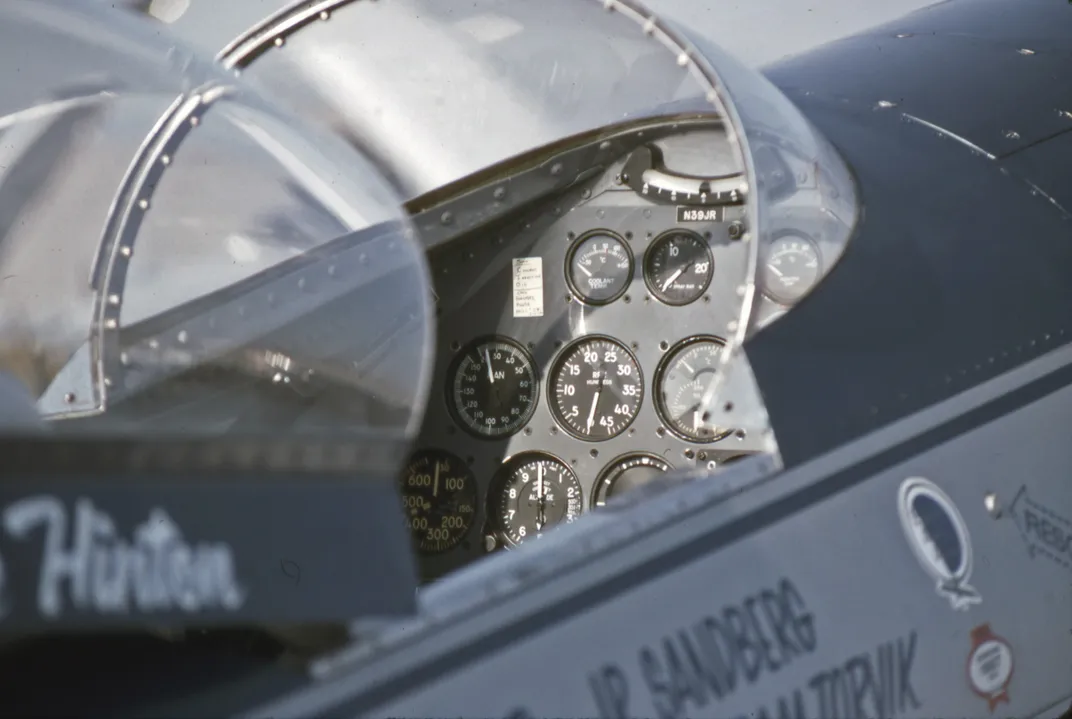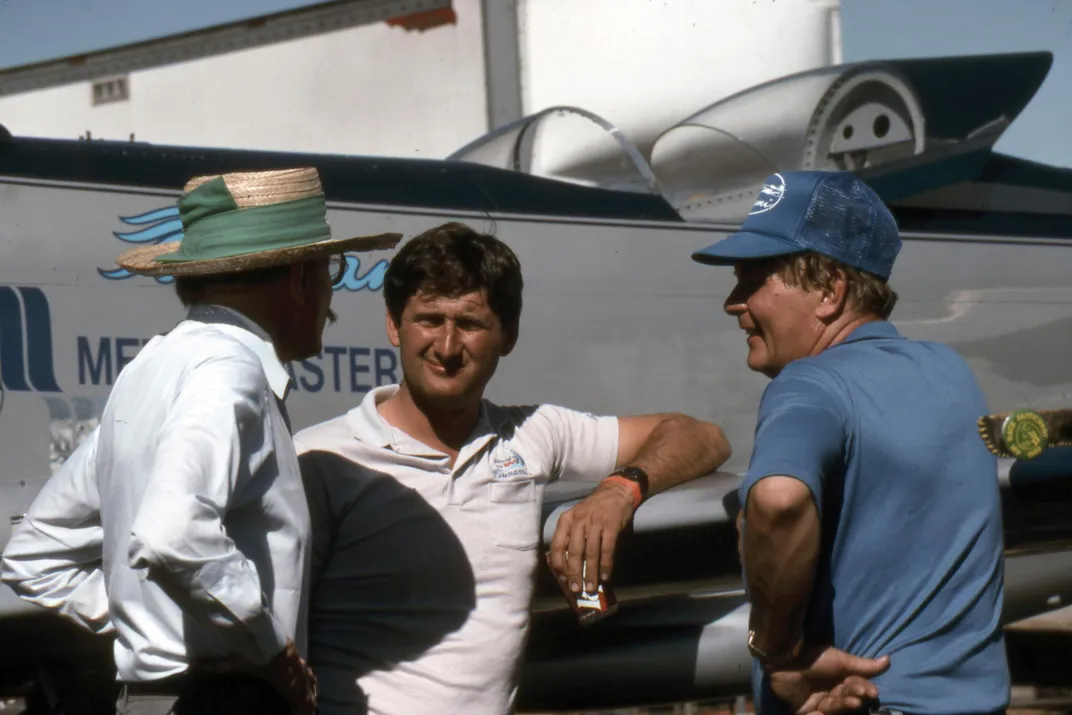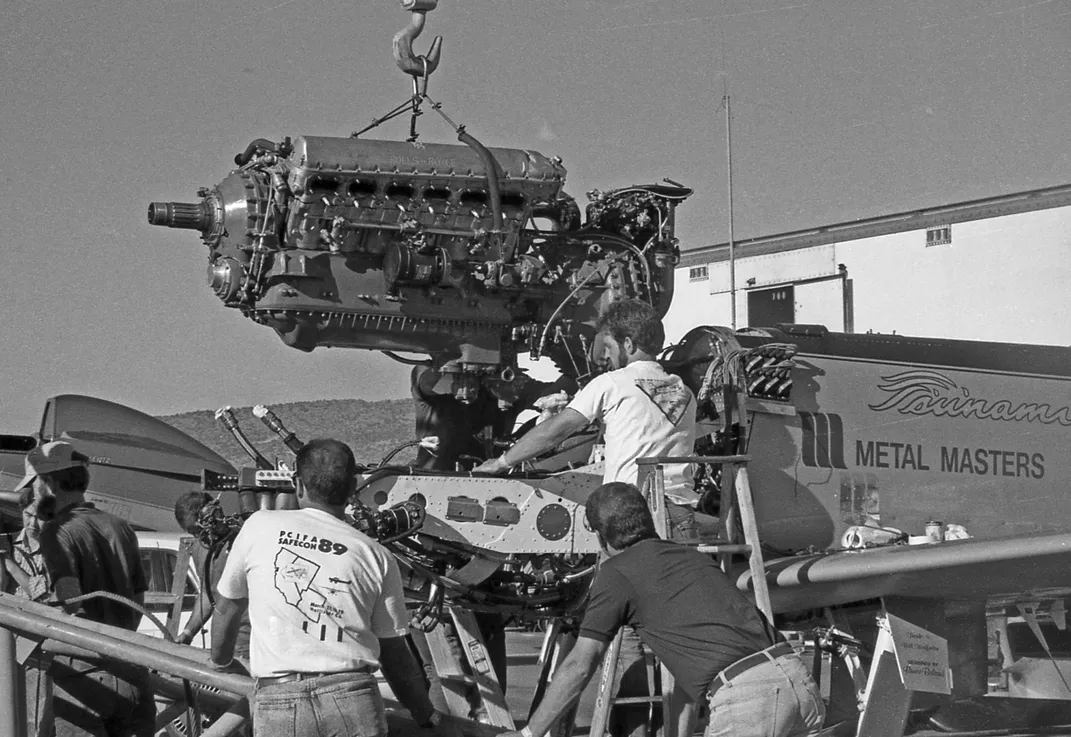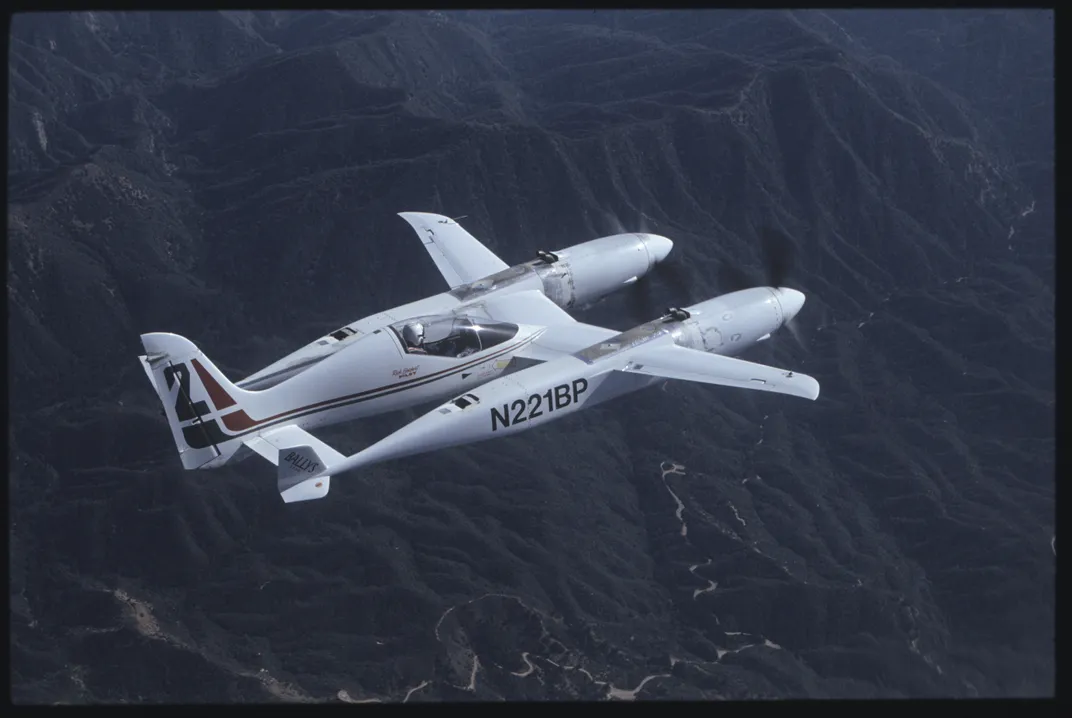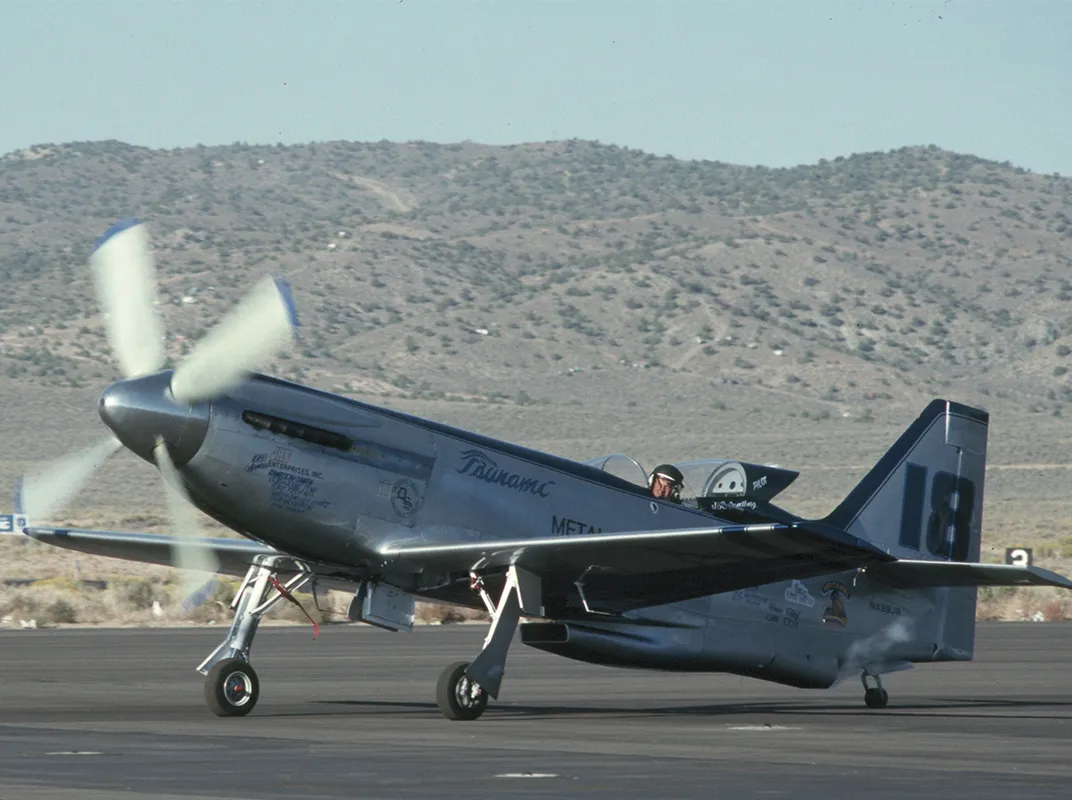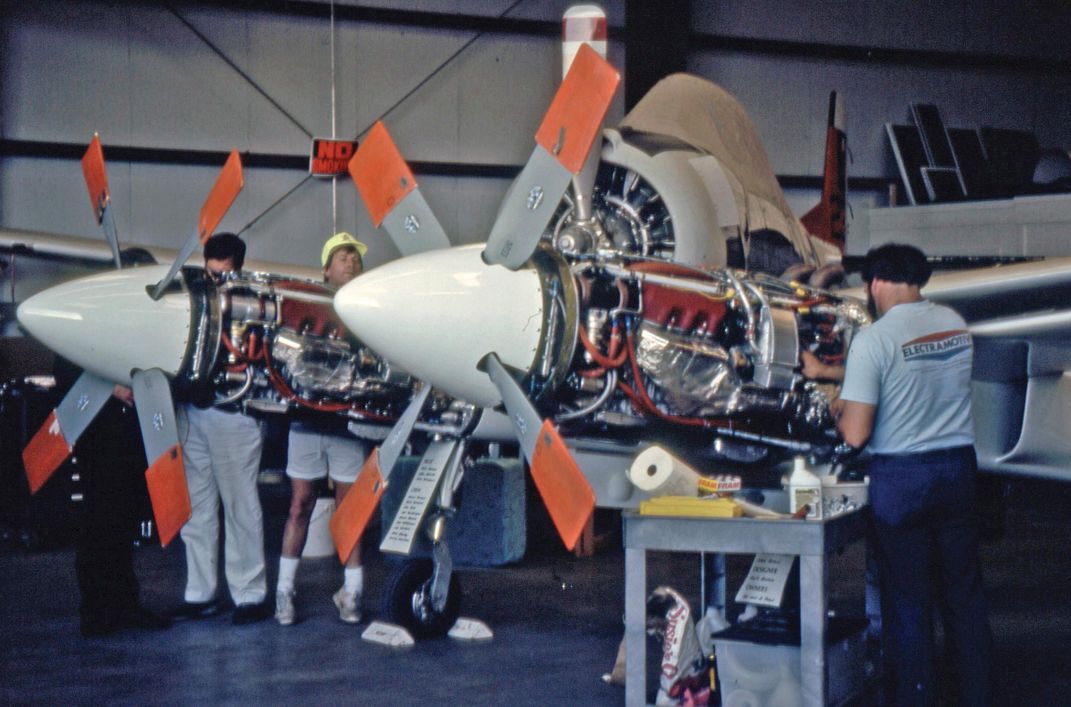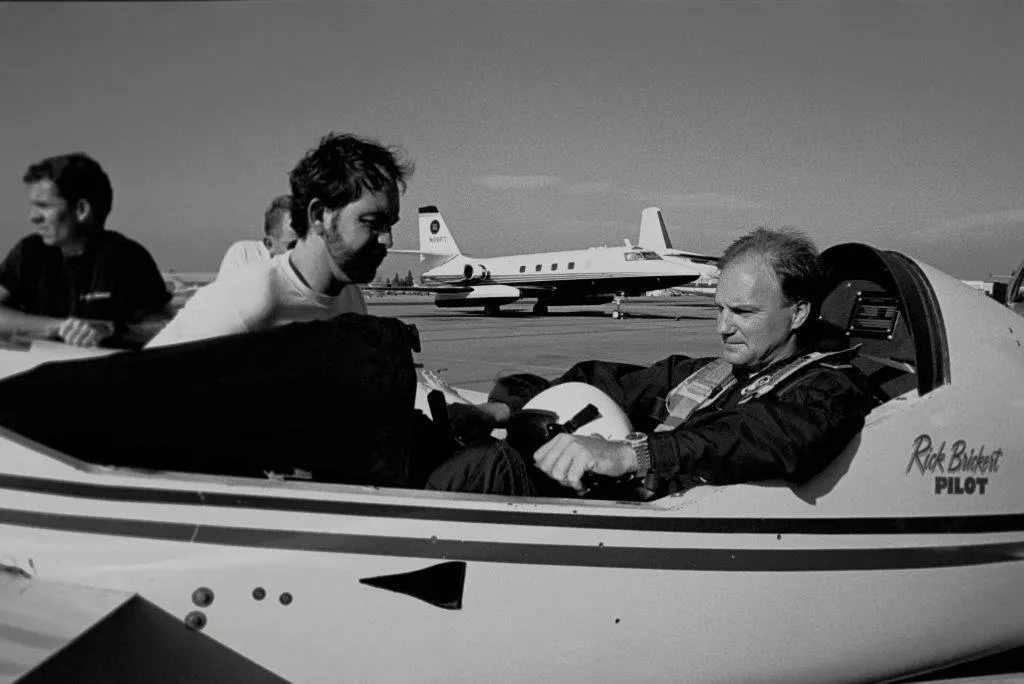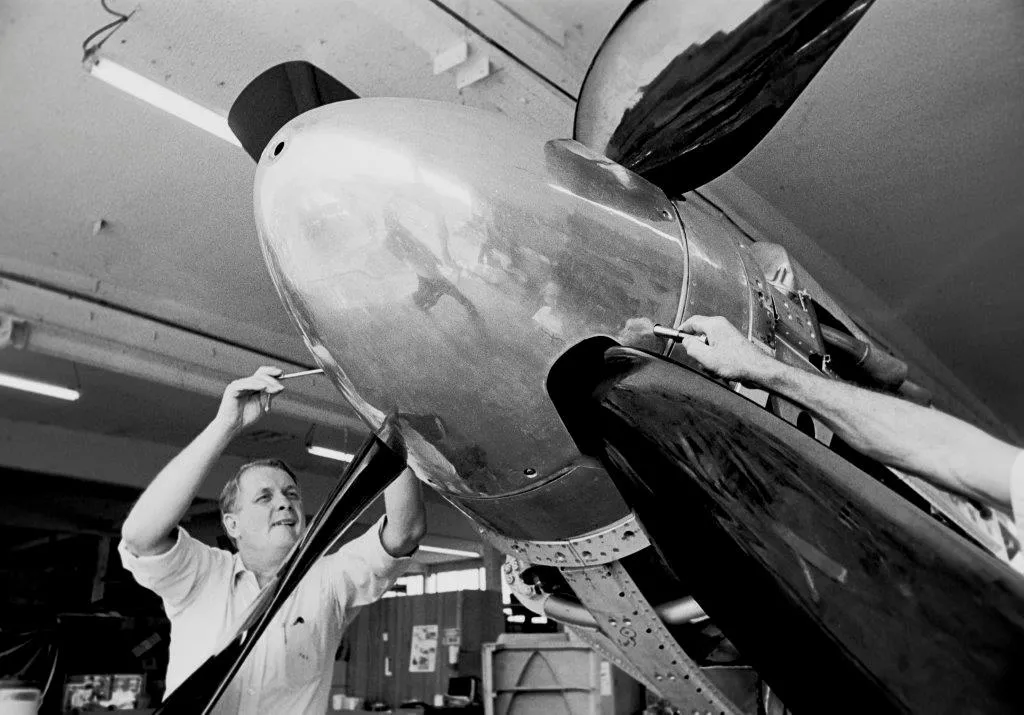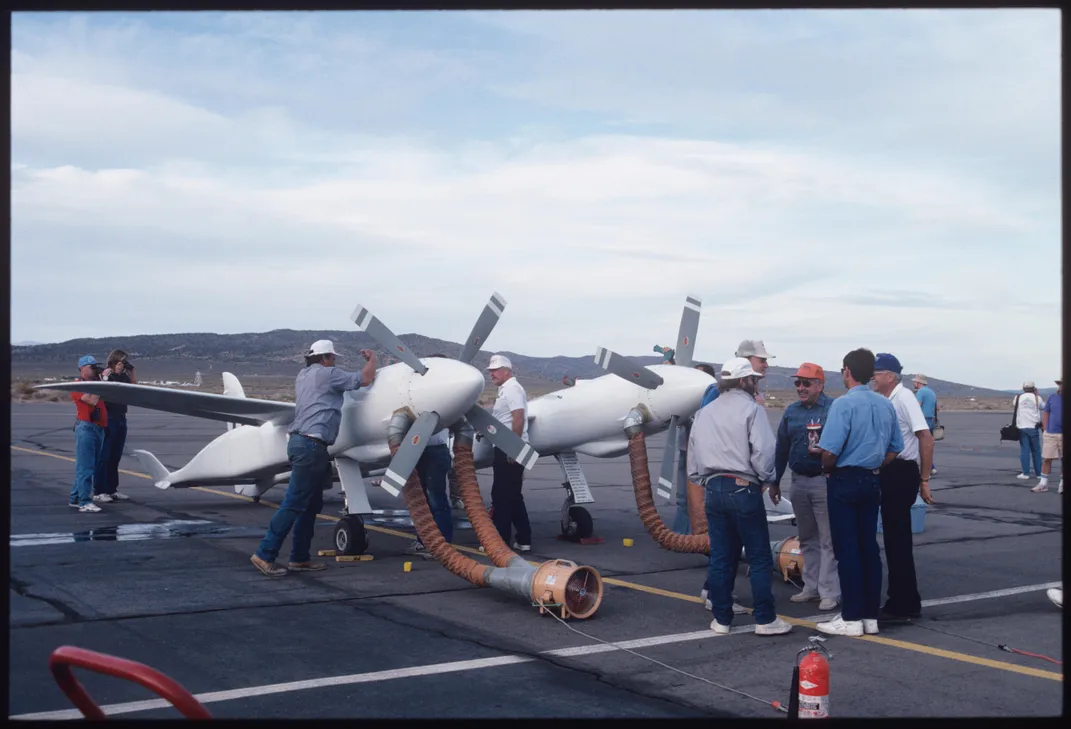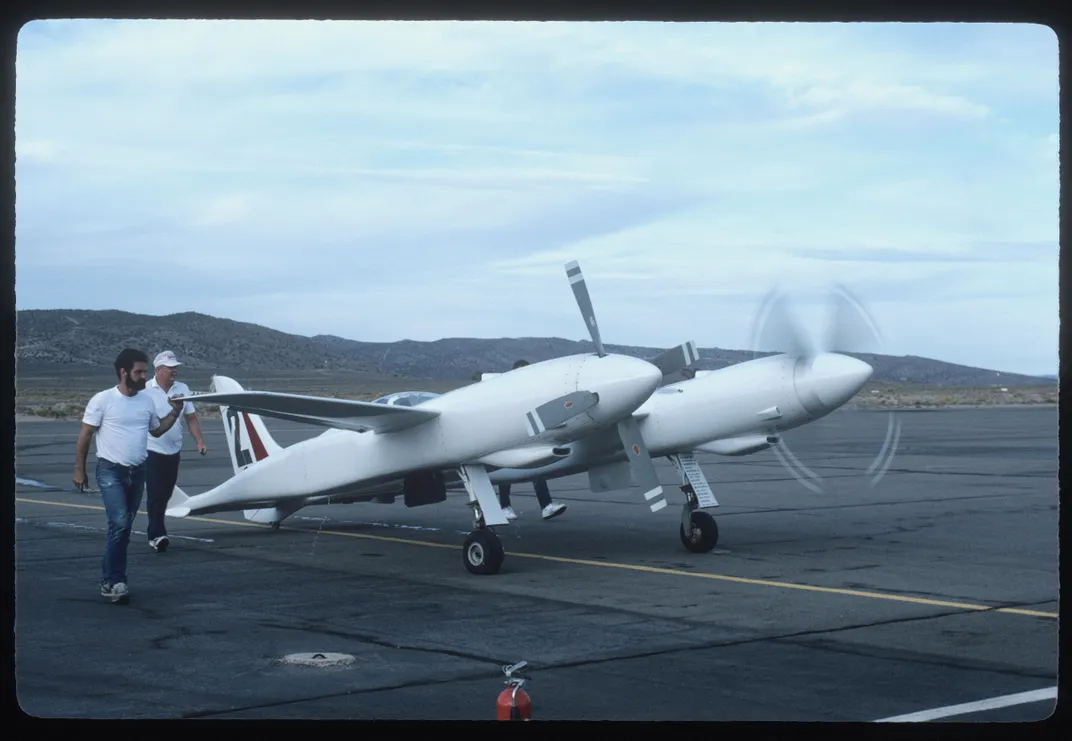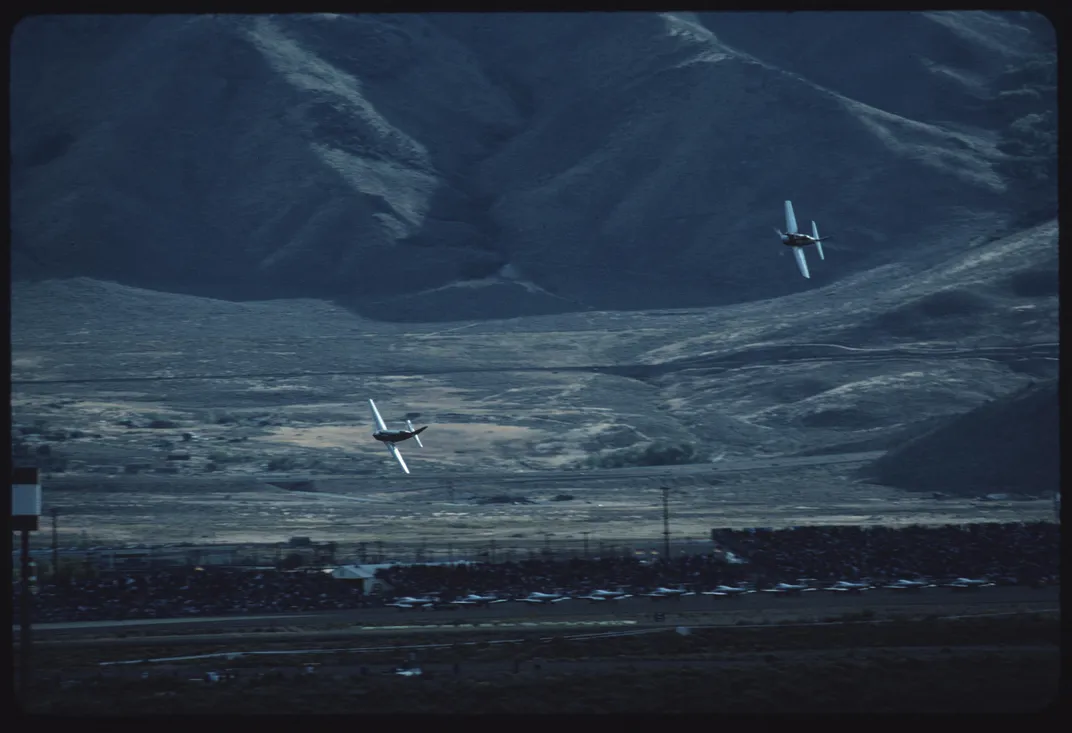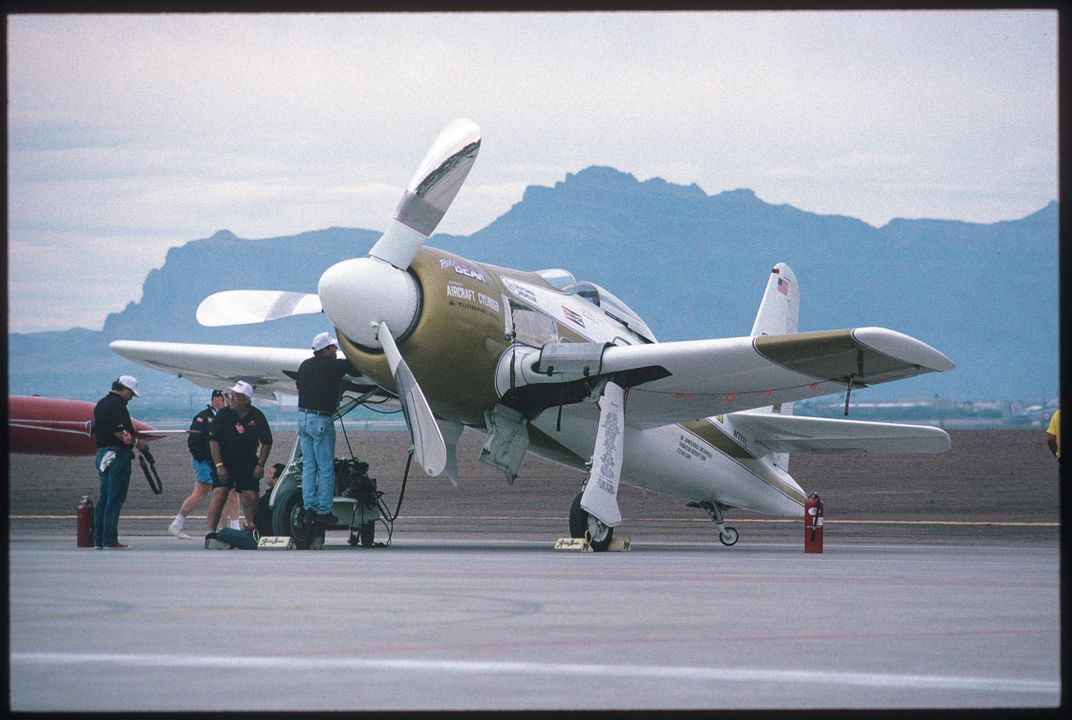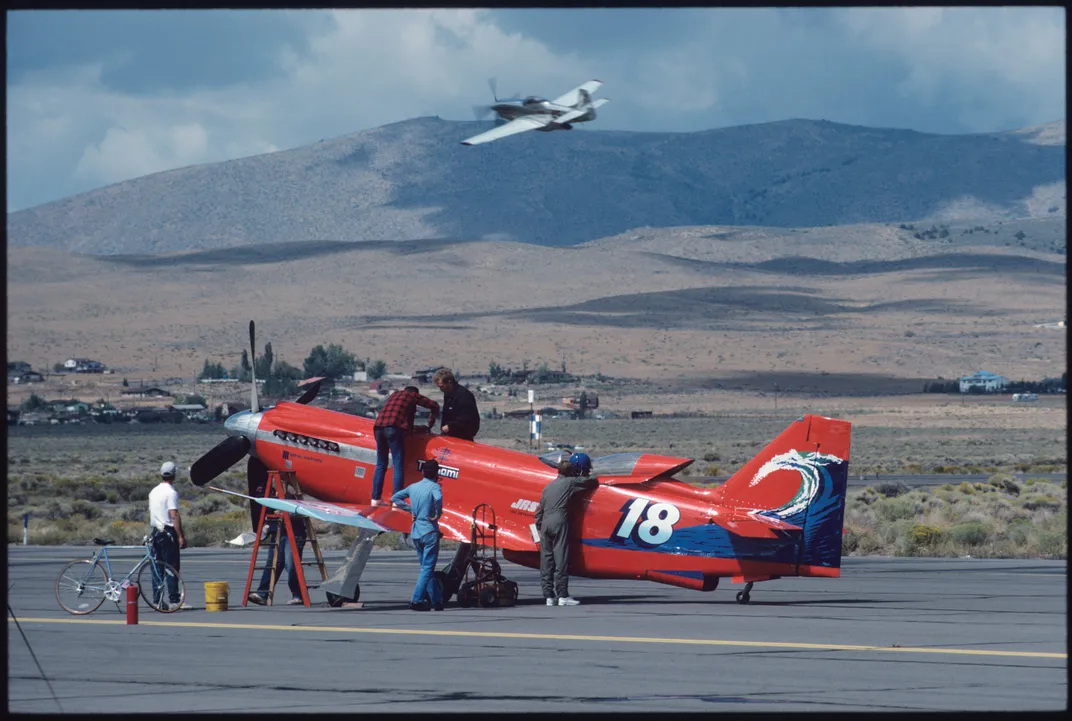Born to Race
Just how close a pair of custom-built racers came to unseating the kings of Reno.
/https://tf-cmsv2-smithsonianmag-media.s3.amazonaws.com/filer/6f/45/6f456c86-209e-490c-b6f3-f6031ef28147/05d_fm2016_metalmasters.jpg)
During the golden age of aviation, following World War I, air racing became a global obsession, bringing a feverish succession of new world records as aviators, contended for the titles of world’s fastest man and machine. The raceplanes they flew were purpose-built: The Schneider Trophy Macchis and Supermarines, the Gee Bees, Howard Hughes’ magnificent H-1—all were unique designs capitalizing on rapid advances in aeronautic and engine technology.
After World War II, jets took over as the world’s fastest airplanes, and the next fastest were cast aside. Surplus warbirds that had been fast fighters became widely available. When the National Championship Air Races started up again—in Reno, Nevada, in 1964—the only airplanes circling the pylons were Mustangs, Bearcats, and the occasional Sea Fury. Speed was now simply a matter of pumped engines, clipped wings, and a fitted canopy. By 1989, a 1946 F8F-2 Bearcat, Lyle Shelton’s Rare Bear, was uncatchable; it set the propeller-driven three-kilometer speed record, 528 mph, and began a decade of dominance at Reno.
To break the absolute speed record and overcome the aluminum grip of ex-World War II fighters on Unlimited races (where, unlike in other classes, anything piston-powered and propeller-driven were then allowed), challengers would have to build an airplane from scratch and just for speed. Proposals and prototypes popped up, with names like Shockwave and MachBuster, but there were only two serious contenders: John Sandberg’s Tsunami and Bob Pond’s Pond Racer. Rarely have two aircraft designed for the same mission looked so different, and the truth is that both teams came much closer to their ultimate goal than is generally acknowledged. That no one in the last two decades has dared to follow in their footsteps is evidence that the three-kilometer absolute speed record is going to be one helluva tough nut to crack.
Tsunami first flew in 1986, but the idea had been hatched seven years earlier under blue Nevada skies, as Bruce Boland and John Sandberg watched 27-year-old Steve Hinton set a new absolute speed record in a highly modified P-51, Red Baron at Tonopah. Red Baron owner Ed Browning had hired Boland and Pete Law, Lockheed Skunk Works engineers who had worked together on air racers since 1965, to modify the airplane for the Reno races; as one reporter later noted, practically every Unlimited racer at Reno had been graced, in one way or another, by the magic touch of Boland and Law (see “Secret Pete,” Sept. 2012). Sandberg ran a company that rebuilt the Rolls-Royce V-12 Merlin engines that powered many of the Unlimited class racers. While Boland and Sandberg saw Hinton set a new record of 499 mph, they saw something else: the possibility to go even faster with a clean-sheet, purpose-built design. It was a hugely ambitious undertaking that nobody had yet attempted. So when Sandberg invited Boland and Law to join the project that became Tsunami, they jumped.
Though it shared the same goals as Tsunami (victory at Reno; the 3-km absolute speed record), Pond Racer was born under a different star. Bob Pond had trained as a naval aviator in World War II (though he never saw combat), and after the war he turned his family’s machine shop into a multimillion-dollar concern. A devoted collector of airplanes, he created a warbird museum, and in 1988 commissioned Burt Rutan’s Scaled Composites to design an airplane that would so dominate the Unlimited class that warbirds would no longer be competitive—and thereby saved from the sacrilege of heavy modifications for the Reno air races, not to mention the crashes that destroyed them. Any airplane that could beat the Bearcat at the races would have no problem snatching the 3-km record.
There are only two ways to make a raceplane faster: more horsepower or less drag. With the Unlimited warbirds already grenading engines on a regular basis, wringing significantly more power out of a Merlin or a Wright radial than one’s competitors was unlikely. So while both the Tsunami and Pond Racer teams focused on drag reduction, Sandberg’s decision to stick with a Merlin—and hide the smallest possible airframe behind it—seemed a brilliant tactic: The engine was race-proven, and well understood. With 3,600 ponies on tap, Tsunami got the “more horsepower” side of the equation right. It was the airframe that was to prove troublesome.
In contrast, the Scaled Composites team had relatively few problems with Burt’s airframe. Rutan considered a number of configurations, but the twin-boom-and-pod design, though more draggy than other layouts, kept the pilot out of the line of fire in the event of engine failure and provided excellent visibility. Chief test pilot Dick Rutan (pilot, with Jeana Yeager, of Voyager’s round-the-world flight in 1986) praised it for “exceptionally good flying qualities—the directional stability was like it was on rails,” and Mike Melvill, who was to later pilot SpaceShipOne to win the Ansari X-Prize, called it “Rutan’s best flying airplane straight out of the box.” Pond Raocer’s problems were almost entirely due to the difficulty of adapting a pair of 1,000-hp, methanol-fueled racecar engines to airplane use (in keeping with program goals, Pond prohibited the use of warbird engines like the Merlin). Pond Racer had less drag than even Tsunami, but was unable to pull more than 640 hp from the engines in flight. It never turned a lap at Reno faster than 400 mph.
In the world of aircraft prototypes, it is generally agreed that you should not put an untested engine in an untested airframe: New engines should go in proven airframes, and vice versa. Andy Chiavetta, renowned builder of Reno Sport Class racers, has a corollary for raceplanes: “Choose your engine, then build the racer around it.”
John Knepp didn’t have either of those options when Dick Rutan phoned in the summer of 1988. Knepp, an industrial physicist, owns the race-engine developer Electramotive, and in the late 1980s, the company’s Nissan VG30 V-6 dominated sports car racing. “Dick called and said, ‘I need an engine that fits inside a two-foot circle and makes 850 horsepower. Can you do that?’ ” recalls Knepp. “I answered ‘You bet!’ ” But Pond Racer was Electramotive’s first venture into aviation, and from the start the engine was beset with challenges. The two biggest problems were the propeller drive gearbox and the packaging: “In trying to squeeze everything into that two-foot-diameter cowling, we had planned on utilizing the space behind the firewall to place engine controls and cooling systems,” says Knepp. “But that space was soon filled with airplane systems, so we kept having to move engine-related components ahead of the firewall.” Space became so confined that the electronic engine controls had to be mounted above the 1,500-degree turbos in an insulated, air-cooled box. “Integrating everything required to get 1,000 hp [upped from the original 850 hp in order to beat Rare Bear’s new record] out of a 3.2-liter, 320-pound engine proved a far greater challenge than Scaled ever imagined,” he says.
Knepp designed and fabricated several thousand parts for the engines, and the team slowly overcame myriad technical problems, from overcooling to engine stuttering caused by severe electromagnetic interference. Packaging remained the ever-present dilemma. “The real Achilles’ heel was that we only had space for a four-quart oil sump where we’d typically have 12,” says Knepp (the sump collects oil after it passes through the engine). Engine problems were exacerbated by the methanol fuel, which indirectly caused the engine to blow oil, further decreasing its already precariously low volume. “The remedy was to increase engine temps slowly, run gasoline, other stuff—patches on patches. Probably several engine failures were caused by running low on oil,” says Knepp, although he also points out that the failures were always due to external systems integration issues, rather than a failure of the core engine itself.
Knepp points out that in the design phase, oil tank size was a relatively minor detail compared to a potentially much more harrowing problem: rotational vibration between the engines, gearbox, and propeller. Such vibrations can destroy an engine, a propeller, or even a whole airplane in the blink of an eye, and yet here the team nailed it. All pilots reported the airplane was so smooth it felt as though it were running on turbines, not reciprocating engines. “I worked quite closely with Electramotive,” says Bruce Evans, Pond’s point man during the build and Pond Racer’s crew chief. “The development of that gearbox from scratch is an amazing untold story.”
In addition to being chief test pilot, putting his life at considerable risk every time he flew the untested design, Dick Rutan worked as project manager of Pond Racer while it was a Scaled contract. He took no pay, but had a gentleman’s agreement with Pond that when the racer was ready for the 3-km, he would be the pilot to attempt the record. Rutan agrees with Knepp that from a technical standpoint Pond Racer’s weak point was engine integration. But in Rutan’s eyes, the biggest problem with Pond Racer was Bob Pond himself.
Though he spent an estimated $6 million-plus, according to two people who worked on the airplane, while developing one of the world’s most sophisticated experimental aircraft, Pond could be inexplicably tight with money, exploding at what he perceived to be unnecessary expenses. He resisted funding the development of a proper thermostat for the engines, doing a full ground vibration test that would tell engineers if the airframe was safe from high-speed flutter, and even paying for tickets to get crew through the gates at Reno. “For him to be involved [in engineering decisions] with that little knowledge was dangerous,” says Rutan, still bitter that he risked his life, only to have Pond transfer the project away from Scaled after the 1991 Reno races. The great irony is that, once Scaled’s construction contract was officially fulfilled, Pond handed Pond Racer over to a rival, responsible for the very warbirds the Pond Racer team was supposed to be defeating on the racecourse: Steve Hinton and his Fighter Rebuilders, down the road in Chino, California.
Pond died in 2007, so we don’t know why he transferred Pond Racer to Chino (the airplane spent a year in Pond’s Palm Springs hangar before the transfer), but it’s not hard to guess: Fighter Rebuilders restored more than 20 warbirds for Pond’s museum, and owner Steve Hinton was a seasoned Reno air race veteran who had been down the 3-km road before—in Tsunami. If Pond was discouraged with Pond Racer’s progress, he may have looked to folks at the top of the racing game to set things right.
**********
Working with engineer and fabricator Ray Poe, Boland and Law spent six years designing Tsunami’s airframe, and drew on extensive experience at both Reno and Lockheed (Boland was an aerodynamicist and Law a thermodynamicist). Sandberg cherry-picked components to assemble the finest race engine he could, and in fact during Tsunami’s construction used a P-51 named Tipsy Too as a testbed for the engine modifications. While many people’s names were painted on Tsunami’s gear doors as construction crew, it is these four—Sandberg, Boland, Law, and Poe—who created it, and it was Steve Hinton who made the first flight in Chino after final assembly.
Compared to Pond Racer’s engine, Tsunami’s was relatively conservative. By the 1980s the design was already 40-odd years old, but the Merlin was the state-of-the-art engine before being eclipsed by jets. Its high horsepower and inline, liquid-cooled design offered advantages over radial engines. “The Merlin’s pretty damned reliable,” says Hinton. “It’s an awesome, awesome engine.” Tsunami’s problems were predominantly due to aerodynamics and mechanical complexity. The airplane used military- and race-proven structures and where possible adapted existing components (such as landing gear). Nevertheless, modifications to the Tsunami airframe were made so quickly that despite extensive flight testing, the team was never really able to get out from behind the eight ball.
After Tsunami’s first flight on August 17, 1986, the team aimed to make it to the Reno races less than a month later. “We made 50 or 60 flights in a very short period of time, along the lines of World War II flight testing,” says Hinton. “The rudder was extremely light: up to 250 knots, it was light; above 250 knots, it was uncomfortable; and at 280 knots—well, it wasn’t fluttering, but it would have if you’d gone faster. We could only increase flight speeds 10 knots at a time, which is why it took so many flights. But you really only get one chance with this flutter stuff.” In the end Tsunami’s rudder was redesigned with a wider chord, and the airplane made it to Reno. But a cooling systems failure kept Tsunami from flying in the championship race.
In the subsequent five years, victory at the races—and an absolute world speed record—always seemed just beyond reach. Sandberg was an inveterate tinkerer, and while his ideas were often brilliant, they were also often untested, and the endless changes drove team members, including even Boland himself, from the project. “At one time I think I counted well over 20 major changes we made to Tsunami over the years,” says Jim Dale, one of the lead crew and currently crew chief for Unlimited racer 232. “We went from a fixed horizontal to a trimmable horizontal, changed the size of the horizontal, changed the size of the elevators, changed the size of the rudder, changed every single flight control system—it might have been pushrods one year and cables the next….” Heating problems associated with the small radiator, oil cooler, and scoop took several years to sort out. (Dale points out that Tsunami ended up with possibly the smallest scoop of any Merlin-powered racer: “I don’t think a cereal box would have fit into the opening when we were done.”) Finally, structural changes to the landing gear and flaps led to crashes. “The airplane should’ve won Reno many times—it should have, and it could have,” says Hinton with a note of matter-of-fact disappointment. “The airplane was really a heartbreak airplane.”
In 1986 and ’87, Hinton was poised to finish strong in the Gold class at Reno only to DNF (Did Not Finish) with cooling system problems. But starting in 1988, Tsunami made it all the way—to the Sunday Unlimited Gold heat—four years in a row. “The third year [1988], it should have won, and it should have won every year after that,” says Hinton. “The only reason it didn’t win that third year was that we had some miscommunication among the crew. An adjustment was made with the water injection system before the main race without a test flight. I didn’t even know they did it until I was coming down the chute. I pushed the throttle up and the induction temperature was over the redline. I radioed in and the reply back was ‘Oh, we should’ve tested that.’ That was a big disappointment.”
**********
Pond Racer, meanwhile, changed teams. After the raceplane was transferred in early 1992 to Hinton’s Chino shop, Dale took over as crew chief from Bruce Evans, and agrees with Knepp that while Burt Rutan’s engineering genius was awe-inspiring, the complexity of Pond Racer’s engines held it back. “Pond Racer had systems,” says Dale. “It had ECUs [electronic engine controls], turbochargers, radiators—it was systems-heavy, but that’s what was required to produce that kind of horsepower.”
In the hands of Rick Brickert, a seasoned race pilot Pond had hired, Pond Racer, despite lacking nearly half its potential horsepower, managed a respectable second place in the 1992 Reno Bronze class: 365 mph. It seemed as though the raceplane had finally found its footing, but the inability to make full power continued to vex the team, and the engine modifications continued. During a flight to test turbo modifications, Brickert experienced total engine failure. North of Chino in the high desert of Mojave, Brickert calmly feathered the prop and threaded the Cajon Pass back to the airport on a single engine.
The outcome of a similar failure later that year in Reno could not have been more different. During a qualification heat at Reno in 1993, the right engine failed, and for reasons not entirely clear, Brickert chose to belly-in on a dry lakebed adjacent to the course, rather than land at the airport. When the aircraft slammed into the lakebed and burst into flames, Brickert was killed; some evidence suggests he may already have been incapacitated by smoke from an electrical fire. This might explain why he made no radio communications on the way down, and why he made no flare or throttle adjustments at touchdown. An investigation revealed the cause of the crash to be the gremlin that had nagged at Pond Racer from the beginning: insufficient oil, leading to connecting rod failure and subsequent seizing of the engine.
Though Pond Racer had never surpassed 400 mph at Reno, the pieces were set up for a potentially brilliant end game. The team had a definitive list of fixes—including a larger oil sump. The next year at Reno could have been Pond Racer’s moment in the sun. Likewise, Tsunami seemed to have worked out the most difficult challenges, only to be undone by the failure of a $10 part.
By 1989, the Tsunami team felt it was time to attempt the absolute speed record; in straight-and-level flight tests, Hinton had seen the racer’s airspeed indicator read 550 mph. The team arrived in Wendover, Utah, in August, just weeks before the Reno races. But on August 21, Lyle Shelton broke Hinton’s old record of 499 mph, with a 528 mph run in Rare Bear in Las Vegas, New Mexico. The ante was upped considerably: Rules require a new record to exceed the current one by at least 1 percent; in this case the target was now more than 533 mph. In test runs Tsunami ran in excess of 500 mph, but the ground crew radioed to abort the attempt due to possible oil breathing problems. In fact two pistons had cracked. The team worked throughout the night, and the next morning Sandberg taxied out to try again—only to taxi back, having smelled gas in the cockpit. A heroic team effort to fix the leak got Sandberg back on the line later that afternoon. The test flight was a success, but a hard landing caused Tsunami’s landing gear to fail, and the racer swerved off the runway. The radiator was packed full of sand, and a wing spar, an aileron, and a flap were bent. The landing gear were splayed, one in, one out. The amount of damage would ordinarily have taken weeks, perhaps months, to repair, but if Tsunami was to race at Reno, it had to be present at registration—just four days away. The team and an army of volunteers worked nonstop. They installed a new engine, and Sandberg flew to Minnesota to fetch four new propeller blades. Bruce Evans—the future Pond Racer crew chief—had come to Wendover simply to watch but was soon enlisted to fabricate a new radiator scoop. By Sunday night Tsunami was ready to fly. Dale and a couple of volunteers from Chino sneaked back into the hangar after dinner and spent the night painting the airplane, much to Sandberg’s delight the following morning. As Tsunami taxied out to depart, the tailwheel collapsed. More hurried repairs, and Tsunami arrived in Reno minutes before the close of registration. In 1991 (Pond Racer’s debut year; the two never raced against each other) Tsunami flew in what was described by observers as one of the best Unlimited finals ever. It lost Sunday’s Gold race by the narrowest of margins.
On September 25, 1991, Tsunami was on approach to landing in Pierre, South Dakota, when one of its many untested modifications, a flap pushrod, failed. The airplane flipped over and crashed, killing Sandberg. The flaps had been a later addition Sandberg had been warned not to install; they were intended to enable him to more easily land at his home base in Minnesota.
Since 2013 the Unlimited category at Reno has been restricted to modified warbirds, so we may never see such purebred propeller-driven racers again. Dale points out that the biggest barrier may not be the speed of sound but the cost of speed. At Reno 1991, Evans, Pond Racer’s pre-Chino crew chief—and crew chief of Voyager’s round-the-world flight—commented to Dale: “I now realize it’s a hell of a lot harder to go fast than it is to go far.” Evans’ comment appears to be accurate: Steve Fossett followed in Voyager’s footsteps. But Rare Bear’s absolute speed record remains unbroken, and unchallenged.

